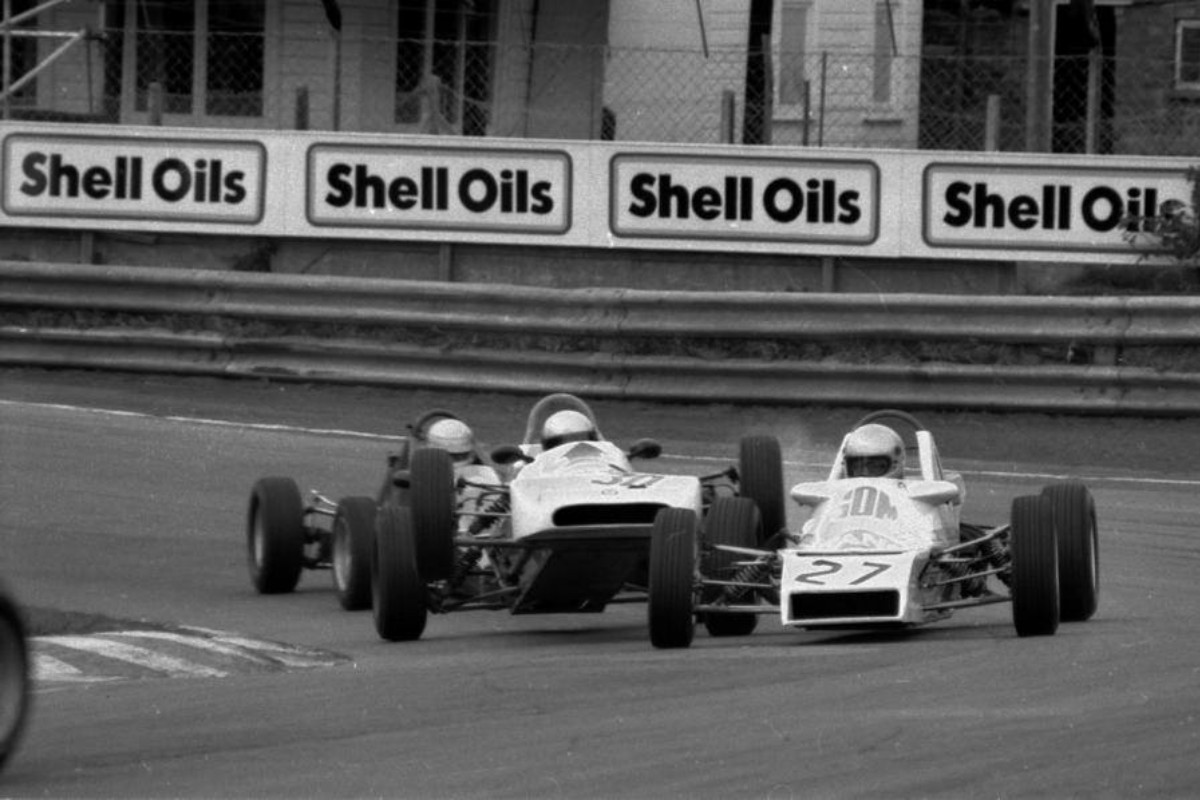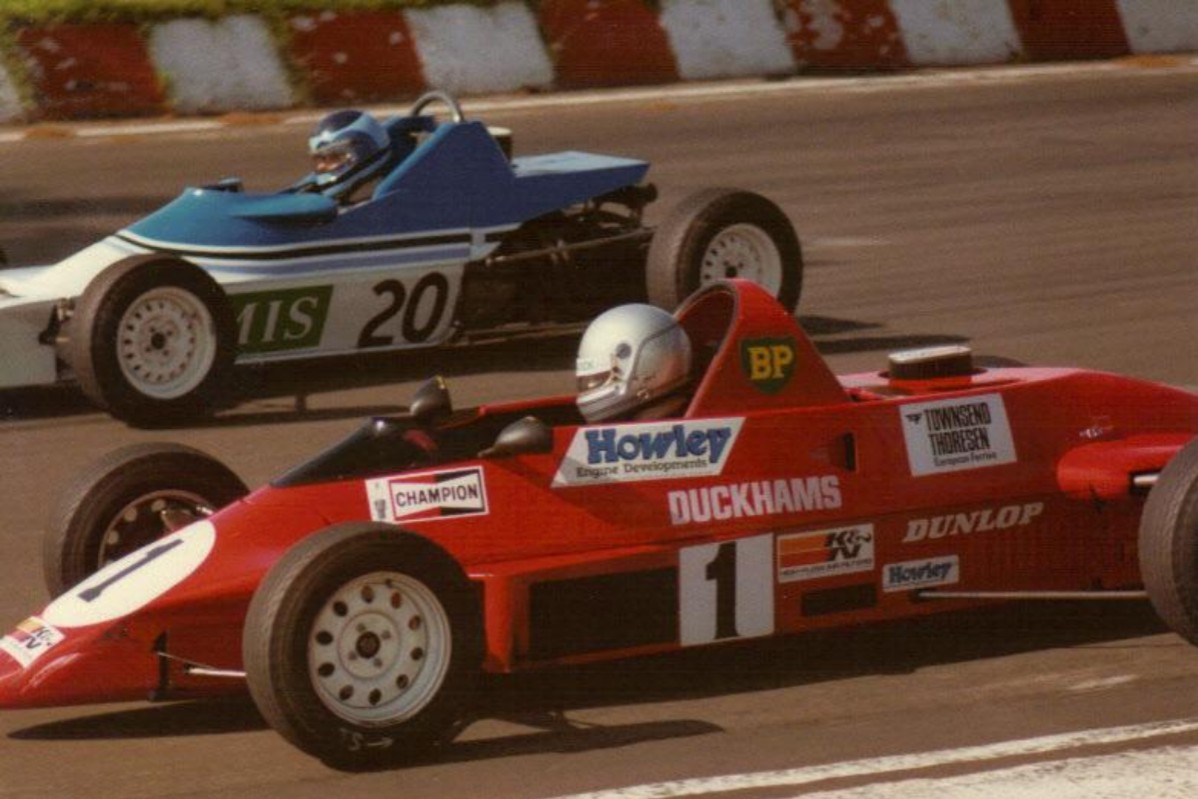 Alejandro Agag and Jean Todt claim Formula E began on the back of a Parisian restaurant napkin in March 2011. They’re wrong, for it was actually created in a creaky Belfast pub about 27 years earlier
Alejandro Agag and Jean Todt claim Formula E began on the back of a Parisian restaurant napkin in March 2011. They’re wrong, for it was actually created in a creaky Belfast pub about 27 years earlier
In 1979, a Formula Ford 1600 championship for pre-’74 cars was launched, followed five years later by a 1974-’78 series. Those seemingly tight descriptions of the championships’ criteria weren’t absolute though, as BRSCC FF1600 coordinator and Formula E co-founder Ian Smith explained to Formula Scout a few years ago.
“There were anomalies where certain cars were eligible by year of manufacturer. Say a Crossle 25F was a ‘74 car, but it wasn’t allowed in because in the day it was so much quicker than the other cars,” Smith explained.
“So it wasn’t purely on years. There were other silly things like a Crossle 32F was a ‘78 car, and when it was ‘74-’78, the Crossle 35F was being used in 1974-’78 but that was a ‘79 car.
“For people that knew their Crossles, the ‘79 35F looked identical to the ’77-’78 32F. The only two differences were, and I don’t even know which one was which now, the nosecone had an opening to the radiator and in one of them it was a bigger aperture than the other one.
“The ‘79 car, the 35F, had a different thickness of metal on the rollover bar behind the steering wheel. That was a heavier gauge metal in the 35F. So to all intents and purposes, although it wasn’t a biggie, it was sort of cheating. And there’s always been cheating in year-defined classes.”
In 1991, the 1974-’78 championship opened its doors to become 1974-’80 FFord. The plot thickens.
“People entered cars that would be technically a year too old or new. For example, the must-have car in the pre-90 FFord to this day, people think is a Reynard 89FF. But that car basically came out in 1987.

Photo: Alan Cox
“If you use an 87FF, 88FF or 88FF, that was no biggie. But if you think, it was also a 90FF, 91FF or 92FF, because they were all basically the same car. They were what was known as chassis plate specials. If the chassis plate was falsified to say it was an ‘88 or ‘89, it was in.
“So we came up with the idea – well, Richard Peacock did. He was a all-round good guy in the FF1600 world, and I jumped to his command. Don’t know why.
“He had racing schools at Aintree and Kirkistown, both of which he sold. To this day he still has Anglesey’s Performance Driving Centre.
“Richard was in Northern Ireland a lot because the Crossle factory was there and he was their agent.
“They were having a meeting in a pub with some Northern Irish FFord people. They decided the way to solve this ‘year’ problem was to reinvent FFord for that era of car.
“If it was a FFord and it had outboard suspension, as opposed to pullrods, then it was in. If you wanted to build a brand new one to an outboard suspension design, you could run a brand new car in FE. Nobody ever did, but the option was there.
“You could also modify cars, that were say a 1983 version of a model where the only outboard suspended one stopped in 1980. You could modify it so you could get in.
“As a couple more pints went down in a pub in Belfast, they said: well that’s sorted then boys, all we need now is a name.

FE frontrunner Alister Lane rear of shot
“So they came up with Formula E, for economy. And it immediately got misconstrued by the FFord world as Formula Cheap, which it wasn’t. It was just that you could keep the older cars going, and there must have been 100s of them under dust sheets in garages and workshops.
“We had a word with BRSCC North West, the one that runs Oulton Park, a chap called Tom Dooley. He was with the North West centre at Oulton from 1953, when the first meeting was held at Oulton, he was out putting fence posts and rope on for spectator control.
“He said BRSCC NW would run our FE series in 1985, and we negotiated that we’d have prize money as well if we had 19 or more entries. £210 as a prize pot. Which was big-ish money in those days when you think a entry was only about £15, as opposed to the £400 now. We always got more than 19 entries. FE became a big success.”
You could say there was an electric mood about the new championship. Races weren’t held in Berlin, Hong Kong or Mexico City, the mix of classic British circuits was popular enough for FF1600 owners.
“In season one we went over to Kirkistown because FE was sort of half-invented over there, and we also got a support race at the FFord Festival.
“Season two we got a sponsor, and the prize money went up to £500 a meeting. FE took off and it ended up with having a qualifying race and a main race because it was always oversubscribed. It became the must-do thing.
“About that time the 1974-’78 championship had changed to 1974-‘80. But it wasn’t that well supported because FE took all the entries. People decided that’s what they wanted to do.”
 There are parallels to the popularity behind FIA Formula E’s growth, which has gone through its boom phase of attracting automotive manufacturers and OEMs already, and began its on-track life at FF1600 favourite Donington Park.
There are parallels to the popularity behind FIA Formula E’s growth, which has gone through its boom phase of attracting automotive manufacturers and OEMs already, and began its on-track life at FF1600 favourite Donington Park.
The current FE shrugs off cancelled races (before and during the COVID-19 pandemic) and the resultant shaky financial ground with enduring aplomb as it continues its unrivalled growth in the motorsport world, but the original FE was undone by a resistant calendar.
“FE went on in leaps and bounds until the very early 1990s when Nicola Foulston took over the Brands Hatch group after the death of her father.”
At the time, Brands Hatch, Snetterton, Oulton Park and Cadwell Park were all under the same ownership, a system that still exists under current owner MotorSport Vision.
“Foulston took over the circuits and went to each to do an open night for interested parties: spectators, competitors, officials, whoever. And fair dos to her, she said: I’m not interested in motor racing, to me it’s just a business.
“They did a survey – not a very big one – of spectators to say what class of cars they liked. To figure out her demographic customer base. She then graded the meetings that she had on her circuits. She created them from A at the top, I think A was touring cars and superbikes. B was a bit less. C, D, E and F at bottom.
“For whatever reason, she decided that Formula E was going to be grade F.”
Once it got down to a D grade, a championship could only take place on two of the Brands Hatch group circuits, an E grade was worse, and championships graded F weren’t granted slots at any of the four circuits. Given FE was a motor club as well as a championship (a rarely seen phenomenon today), the competitors were not impressed.

FF1600 racing at Brands Hatch in the modern day
From thereon FE lacked some diversity in venues, although it was still running at Formula 1 venues Silverstone and Donington Park, as well as the high speed Thruxton, Wales’ Pembrey circuit and Scotland’s Knockhill and Ingliston.
“All went well,” continues Smith. “But people were a bit pissed off.”
Oulton and Brands were driver favourites, and it was particularly erring that low profile (compared to now) Volkswagen Beetle and Citroen 2CV championships were graded B. According to Smith, British Formula 3 was one lower than that.
“We stuck it out for another couple of years, and then just got a bit fed up with it and thought: stuff it, we’ll let the Classic FFord (nee 1974-’80 FFord) keep going. And that was it basically. It died in 1993.”
In 1994, the Pre-’74 championship, 1974-’80 FFord and FE were amalgamated into the Classic FFord championship that races today, and which switched from BARC to HSCC co-ordination last year. Some still speculate that the FIA’s two single-seater world championships may stage a merger in the future too, a take fervently refuted in both paddocks.
Being a championship catering for already dated cars, the original FE was low on the big-name drivers or rising talents that British FFord attracted. There were some interesting cameos though, such as Mark Goddard.
The British F3 National Class race-winner deputised once for Peter Eccleston in 1988, and with zero FF1600 experience managed to take pole and finish second in a Crossle 25F. He later took a class win in the British Touring Car Championship, then helped launch, run and win Asian F3 with his Eurasia team operated with the assistance of Asian talent founder and fellow former junior single-seater racer Piers Hunnisett. For more on Hunnisett’s dramatic Asian exploits, click here.
FE does have a legacy of its own, beyond its name, in that many of the chassis run in Classic FFord today are the same ones that raced from 1985 to ’93.
If you own one of those cars, the next time somebody approaches you at the bar and asks what you do, you can say: “I drive Formula E cars for fun.”
